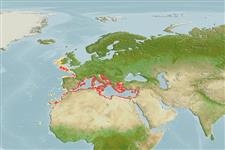Classificação / Names
Common names from other countries
Referência principal
Tamanho / Peso / Idade
Max length : 100.0 cm TL macho/indeterminado; (Ref. 3397); common length : 50.0 cm TL macho/indeterminado; (Ref. 3688); Peso máx. publicado: 14.3 kg (Ref. 40637)
Length at first maturity
Lm 34.6 range ? - ? cm
Ambiente
; marinhas bentopelágico; intervalo de profundidade 0 - 200 m (Ref. 3688), usually 15 - 50 m (Ref. 54220)
Clima / Intervalo
Subtropical, preferred 19°C (Ref. 107945); 56°N - 12°N, 23°W - 42°E (Ref. 54220)
Distribuição
Eastern Atlantic: British Isles to Cape Blanc, Mauritania; (exceptionally further south) Senegal and around the Canary Islands and Madeira. Common south of 40°N (Spain, North Africa) in the Mediterranean (Ref. 4781).
Países | Áreas FAO | Ecossistemas | Ocorrências | Introduções
Descrição breve
Espinhos dorsais (total): 11; Raios dorsais moles (total): 11-12; Espinhos anais 3; Raios anais moles: 7 - 9. Body oval and compressed. Canine teeth, with 4 to 6 anterior teeth very developed in each jaw.
Categoria na Lista Vermelha da IUCN (Ref. 115185)
Ameaça para o homem
Harmless
Utilização humana
Pescarias: espécies comerciais; Aquacultura: espécies comerciais; peixe desportivo: sim
Mais informação
ReferênciasAquaculturaPerfil para aquaculturaEstirpesGenéticaFrequência dos alelosHereditariedadeDoençasProcessamentoMass conversion
Ferramentas
Relatórios especiais
Descarregue XML
Fontes da internet
Estimates of some properties based on models
Phylogenetic diversity index
PD50 = 0.5001 many relatives (e.g. carps) 0.5 - 2.0 few relatives (e.g. lungfishes)
Nível Trófico
4.5 ±0.4 se; Based on diet studies.
Resiliência
Baixo, tempo mínimo de duplicação da população 4,5 - 14 anos (K=0.1; tm=2-3)
Vulnerabilidade
High to very high vulnerability (66 of 100)
Categoria de preço
